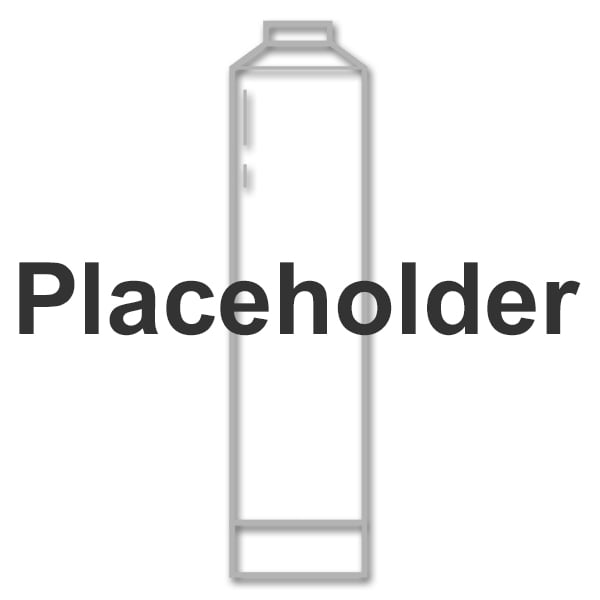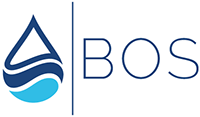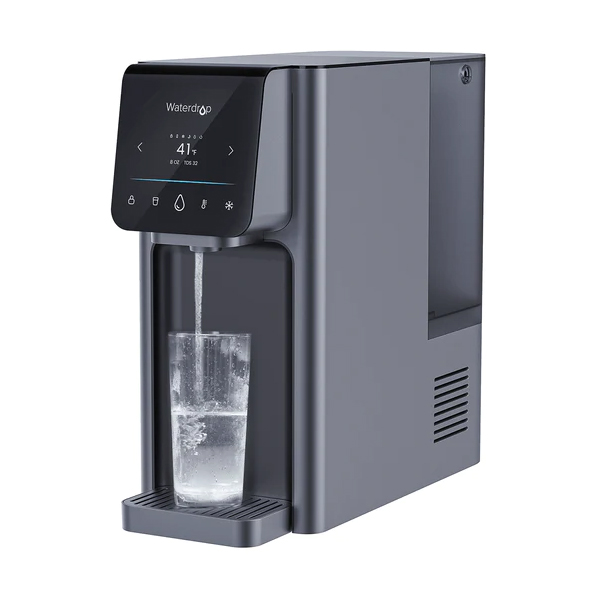Review: Amway eSpring Water Filter (10-0188)
Written by: Gene Fitzgerald // Last Updated: Dec 18, 2023
This page may contain affiliate links. If you buy a product or service through such a link we earn a commission at no extra cost to you. Learn more.
The Amway eSpring (model number 10-0188) is a countertop water filter that can remove more than 145 potential contaminants. It has a filter life of 1 year (1,320 gallons) and costs $230 in yearly maintenance. Sounds like a match? Not so fast! Aside from all the pros, there are several cons you need to know about. Let’s get into it!

Amway eSpring Water Filter |
|
| Price: | $$$ |
| Filter Process: | Sediment Filtration, Carbon Block, UV |
| Filter Stages: | 3 |
| Filter Life: | 1,320 Gallons |
| Annual Cost: | ~$260 |
|
Overall Rating: 3.5/5.0
|
|
Amway eSpring Water Filter – All Specs
- Model: eSpring 10-0188
- Last Price: $1,179.00
- Annual Maintenance Cost: ~$260
- Filter Media/Process: Sediment Filtration, Carbon Block, UV
- Filter Stages: 3
- Flow Rate: 0.9 gpm
- Filtering Capacity: 1,320 gal or 1 Year
- Height: 12.75”
- Diameter: 6.75”
- Water Temperature: 40-86 °F
- Water Pressure: 15-125 psi
- NSF Certifications: Standard 42, 53, 55 (Class B), 401
- Warranty: 3 Years (Limited)
Amway eSpring – Key Features
As a countertop water filter, the Amway eSpring Water Filter has to be attached to a kitchen faucet. It uses a diverter valve for that. The valve allows you to switch between filtered water and unfiltered water straight from your existing faucet. Once connected, the system works using a 3-stage filter process:
- Sediment pre-filter paper layer blocks larger floating particles
- Carbon-block filter removes chlorine, chloramine, heavy metals such as lead, asbestos, bad taste and odor, and all kinds of organic chemicals among other stuff
- UV lamp inside the carbon core (the lamp is integrated into the filter cartridge) eliminates more than 99.99% of bacteria and viruses, says Amway
This filtration process has been third-party certified by both the NSF and the WQA against NSF/ANSI standards 42, 53, 55, and 401. In other words, filtration effectiveness is guaranteed.
NOTE: The UV system is a so-called Class B system. This means it isn’t designed to handle microbiologically-contaminated water. Its role is to reduce normally occurring non-pathogenic microorganisms. As such, it’s a supplemental treatment for already treated public water supplies that have been deemed safe for human consumption. In essence, it’s not designed to decontaminate water from scratch. The purpose is to prevent water from becoming stale or stagnant.
Filter life is 1 year or 1,320 gallons per cartridge. We estimate $260 in annual replacement cost which is more than we would have expected. Flow rate? 0.9 gallons per minute which is fast enough to avoid long waiting times but not nearly as fast as a regular kitchen faucet.
eSpring Water Filter Pros
The eSpring Water Filter allows beneficial minerals like magnesium, fluoride, and calcium to remain in the water.
Also, it uses “Smart Chip Technology” that keeps you updated on your filter status (light on the monitor panel means it’s time to replace your filters). It doesn’t get any more convenient than that. Plus, the UV lamp only comes on when it’s needed, saving energy and preventing water from heating up (a sensor detects when water is flowing).
Finally, there’s a three-year limited warranty and a 120-day satisfaction guarantee in case anything goes wrong.
What Contaminants Are Being Removed?
As mentioned before, the eSpring UV water purifier is tested to remove over 145 contaminants. Here are some of them with their corresponding reduction rates:
- chlorine 95%
- chloramine 95%
- asbestos 99%
- lead 95%
- mercury 90%
- MTBE 95%
- Radon 94%
- Phenytoin, Atenolol, TCEP, Ibuprofen, and other emerging compounds (95%)
- Dozens of VOCs (up to 99%)
- and many other organic chemicals
- Bad taste and odor
Installation
Note: The eSpring filter system is placed on the countertop with the tubing and diverter attached directly to a faucet. This is why it won’t work with pull-out, sprayer-type, or any special designer faucets. What you need is a standard-sized cold water faucet.
Components needed for installation:
- Diverter
- Tubing
- Tubing supports
- Faucet adapter
- Tubing removal tool
- Tie straps
Here’s how the installation goes:
- The first step is to attach the diverter. To achieve this, unscrew the aerator and washer from the end of your faucet, then position the diverter on the faucet and hand tighten the textured collar in a counterclockwise direction until secure. (If that doesn’t work, you can fit the suitable textured adapter with washer and internal threads to the end of your faucet. If your faucet has internal threads, simply attach the appropriate adapter with external threads to the end of your faucet.)
- Next, attach the tubing to the diverter. Unscrew and remove the textured nuts. Then, with the threads facing outwards, insert the large nut into the large tube and the tiny nut into the tiny tube. Fit the large tube onto the large barb and the tiny tube onto the tiny barb, then screw the nuts on the barbs and hand tighten (secure the tubing to the faucet with the tie straps).
- After fitting the tubing to the diverter, attach the tubing to the water purifier. To do this, place the eSpring in a location of your choice.
- Remove the top shroud and electronic module. If the tubing is excessively long, use a sharp knife to trim. Ensure the cut is clean and straight, forming a flat tube end.
- Place each tube into the designated positions on the bracket until you reach the marked points (or until you can no longer see the marks). Note: There’ll be some resistance before the tube is completely installed. Turn on the cold water faucet and pull out the diverter pin.
- Check for leaks.
- Turn the water off and push the pin in after each use. Don’t forget to check the system for leaks even while you’re already using it.
Other ways to install the system can be found in the manual.
The Package (Parts)
- eSpring Water Filter
- Power Adapter
- Cartridge
Maintenance
The eSpring’s filters last a long time (1 year or 1,320 gallons). Again, the system reminds you when it’s time to replace. The Smart filter indicator gives two warnings:
- The early warning tells you that it’s time to order a replacement. When your filter has less than 10% of its rated life remaining (calculated either by time or the amount of water filtered so far), the last bar on the replace cartridge gauge will flash, and the system will beep while in use.
- The final warning tells you it’s time to replace the cartridge. You’ll notice that the cup icon shifts from blue to red, the cartridge icon flashes, the lights on the replace cartridge gauge vanish, and your system beeps every two seconds while in use. This means you need to swap filters immediately.
Here’s how to replace filter cartridges :
- Disconnect the power adapter from the electrical socket.
- Shut off the water supply to the purifier. Position the purifier in the sink. Shut off the cold water supply and turn on the faucet to let the water drain. Keep the faucet open.
- Remove the top shroud, the electrical module, and the tubing removal tool.
- Use an ink pen to draw a line across the top of each tube where it meets with the rings on the purifier.
- Press the removal tool against the rings with your fingers, then pull the tubes out firmly with the opposite hand while keeping the rings depressed.
- Unscrew to remove the retaining ring, then lift the bracket handle to remove the bracket and used cartridge. The UV lamp in the cartridge contains mercury. You MUST dispose of it according to your local, state, and federal laws.
- Pour out the water from the base, then inspect the upper interior surface of the base and the seal, and remove any lingering dirt.
- Insert the new cartridge into the bracket.
- Reinsert the bracket into the base.
- Screw on the retaining ring until it’s secure. There should be no visible threads below the retaining ring.
- Fit all tubes back in their correct locations, then turn on the cold water supply and pull the diverter pin. Check for leaks.
Manual
Here is a link to the official manual:
NSF and Other Certifications
The Amway eSpring is certified by the NSF and WQA against standards 42, 53, 55, and 401.
NSF 42 certifies it for reduction of chlorine, chloramine, taste and odor, and nominal particulates Class I. Its NSF 53 certificate means it can remove chlordane, asbestos, lead, mercury, MTBE, radon, microcystin, VOCs, toxaphene, PFOA, and PFOS. It’s also certified for NSF 55 for its Class B disinfection properties. Its final NSF certification, NSF 401, clears it for the reduction of atenolol, bisphenol A, DEET, metolachlor, carbamazepine, estrone, linuron, ibuprofen, meprobamate, naproxen, phenytoin, nonylphenol, TCEP, TCPP, and trimethoprim.
Here are the same certificates awarded by the WQA: 42, 53, 55, and 401.
Earlier Product Versions
This product has an earlier version that uses the same carbon filter. However, it doesn’t have a UV lamp.
There is also an under-the-sink version.
eSpring Water Purifier Cons
I’ve mentioned it in the introduction, there are several downsides to the Amway eSpring which we’ll discuss next.
- It’s expensive. It costs $1,179 and around $260 in annual maintenance. This is a lot more than we would have expected considering that this is basically a carbon water filter. True, there’s a UV lamp in each cartridge, but it still feels overpriced.
- Its filtration abilities are limited. Its filtration media does not include ion exchange resin for example, so it isn’t great at removing many heavy metals and salts in particular. Although it’s been tested for over 145 contaminants, many of those are organic chemicals that can be removed by activated carbon very easily. Anything outside activated carbon’s range (like chromium 6) remains in your water.
- The system is incompatible with anything other than standard-sized faucets.
- We are not sure if eSpring’s claim is accurate that the system “destroys more than 99.99% of waterborne bacteria and viruses”. After all, the UV system is a “Class B”, which isn’t intended to treat contaminated water. It’s only good for reducing the amount of normally occurring non-pathogenic microorganisms in already disinfected water or water deemed acceptable for human consumption. In essence, the UV system takes out lingering microbes and helps prevent water from tasting stale. You shouldn’t rely on this system if your water contains dangerous bacteria or viruses, though.
- The UV lamp in the filter cartridge contains mercury. Thus, you need to dispose of it according to applicable laws.
Amway eSpring Review: Our Verdict + Best for
Here’s what we think: We like that there are NSF certifications and solid reduction rates for contaminants the Amway eSpring Water Filter has been tested to remove. Unfortunately, the system only uses activated carbon as a filter media, which limits its filtration range. Then you shouldn’t use it thinking it’ll eliminate any harmful pathogens. It’s only designed to improve the freshness of microbiologically-safe water. But the biggest issue we have is the very high price and annual maintenance costs. Considering what this system offers, we rate it 3.5 stars.
Our Rating in Detail:
- Filtration Performance: 4.0/5.0
- Filter Capacity (Life): 5.0/5.0
- Purchase Price: 2.0/5.0
- Annual Cost: 4.0/5.0
- Overall: 3.5/5.0
Comparison to Other Countertop Water Filters
Below, we’ll compare the eSpring to the Waterdrop A1 and the RKIN U1. These are not simple countertop water filters that feature UV – they’re reverse osmosis systems (with UV) that also provide hot and cold water. But most importantly, they’re far more affordable than the eSpring.

Amway eSpring |
|
| Price: | $$$ |
| Filter Process: | Sediment Filtration, Carbon Block, UV |
| Filter Stages: | 3 |
| Filter Capacity: | 1,320 gal |
| Annually: | ~$260 |
|
Overall Rating: 3.5/5.0
|
|
Let’s start with the Waterdrop A1: The Waterdrop A1 excels in RO water purification. It also uses effective pre and post-filtration that further improves contaminant reduction. The system eliminates a wide range of contaminants, including organic chemicals like pesticides and PFAS, sediments, bad tastes and odors, chlorine, heavy metals, salts, and a lot more. It’s been NSF-tested against a bunch of contaminants, including chromium 6, lead, chloramine, arsenic, and fluoride. It also includes a UV lamp for added protection against microorganisms.
Compared to the eSpring, the Waterdrop A1 offers broader and more powerful filtration. Plus you can control water temperature (cold, ambient, and hot) and cup size from the front panel. Additionally, it displays the TDS level of the output water, ensuring transparency about water quality.
The system requires no installation and features a filter life indicator, eliminating guesswork. With an annual maintenance cost of around $130, the Waterdrop A1 proves to be a more economical choice than the eSpring. It has a 30-day satisfaction guarantee and a 1-year warranty.
Its major con is that the Waterdrop A1 has no official NSF certifications, and as an RO system, it wastes 1 gallon of water for every 2 gallons filtered.
Next on our comparison list is the RKIN U1, another countertop reverse osmosis system that also heats and cools the filtered water.
It has RO combined with pre and post-filtration, ensuring great effectiveness. The RKIN has been NSF-tested against 5 contaminants (chromium-6: 99%, TDS: 91-94%, lead: >99%, fluoride: 93-98%, PFOA and PFOS: 97-99%). Plus, it goes beyond tackling pesticides, VOCs, odors, taste, sediment, THMs, salts, and heavy metals. It also has a remineralization stage that reintroduces healthy minerals into the filtered water and infuses it with hydrogen (optional). Equipped with a UV lamp, the U1 offers a broader and more powerful filtration experience than the eSpring.
You can also customize water temperature and cup size effortlessly from the front panel.
Like the Waterdrop A1, the RKIN U1 requires no installation. You can keep track of the filter life with the filter life indicator. Annual maintenance costs range from ~$145-290, similar to (or cheaper than) the eSpring. Finally, there’s a 1-year warranty and a 1-year money-back guarantee.
Drawbacks? As an RO system, the RKIN U1 has a 1:1 wastewater ratio and it lacks NSF certifications. Some users have also reported problems with leaks.
Final verdict: We favor the Waterdrop A1. It is the most affordable of the three yet highly effective. We assume the RKIN U1 to be equally effective but it costs more upfront and to maintain. The Amway eSpring is effective at removing certain types of contaminants, especially organics, but we feel it is overpriced.
This completes our review of the Amway eSpring Water Filter. If you have any questions please don’t hesitate to leave a comment below!
Information provided on BOS is for educational purposes only. The products and services we review may not be right for your individual circumstances.
We adhere to strict editorial guidelines. Rest assured, the opinions expressed have not been provided, reviewed, or otherwise endorsed by our partners – they are unbiased, independent, and the author’s alone. We fact-check all content for accuracy. It is accurate as of the date posted and to the best of our knowledge.



